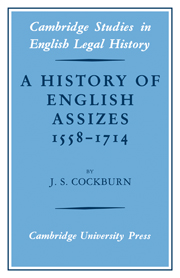Preface
Published online by Cambridge University Press: 07 October 2011
Summary
A study of assizes during the critical one hundred and fifty years after 1558 needs little justification. The influence of the courts of law, as Professor Elton has recently remarked, pervades the history of the sixteenth century; their influence in the seventeenth century was in a sense even more dramatic. Tudor–Stuart historians cannot ignore the courts; and yet we know virtually nothing about them. The consequences are predictable: ‘rather superficial generalizations unburdened by technicalities, and the perpetuation of legends’ mainly invented in the late seventeenth century.
Assizes, in particular, deserve more serious consideration. For more than six centuries the system by which judges from Westminster visit some fifty provincial towns to deliver gaols and try civil cases by writ of nisi prius has continued virtually unchanged. Surviving unscathed the comprehensive reorganization imposed by the Judicature Acts upon the older common law courts, assizes can therefore claim an unbroken tradition unequalled by any other court of law still in existence. For more than a century, however, periodical reviews have threatened, without ever quite achieving, complete reorganization of the ancient system. Now, on the heels of yet another report recommending widespread rationalization of the circuit structure, an account of assizes at the zenith of their power and respect seems sadly appropriate.
When one considers the importance of assizes to local justice and administration, the durability of the system, and the extent to which it has been exported to countries overseas, it is surprising that no full-scale study has previously been attempted.
- Type
- Chapter
- Information
- A History of English Assizes 1558–1714 , pp. ix - xivPublisher: Cambridge University PressPrint publication year: 1972

